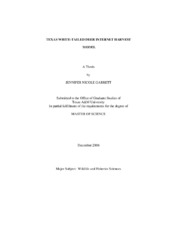| dc.description.abstract | White-tailed deer (Odocoileus virginianus) is an intensively managed game species throughout Texas and the United States. Modeling is a tool that has been used to evaluate various management practices and their potential impacts on wildlife populations; however, many existing models are complicated for the average land manager, require a significant amount of demographic data that may not be readily available, or require expensive software. I developed a white-tailed deer (WTD) harvest model, Texas Deer Manager (TDM), using STELLA® (High Performance Systems, Inc., Version 7.0.3) and NetSim Creator® (High Performance Systems, Inc. Version 2.0), that incorporates the field data that are currently collected and/or can be easily collected, and can be used by interested landowners and state biologists. Unlike other population models specific for WTD, my TDM simulation model has an easy-to-use interface and is available on-line via the Internet. Age classes in the model are represented as fawns (<12 months), yearlings (1-2 years), and adults (>2 years) for each sex. Harvest is controlled by the model user. Currently the parameters such as survival and fecundity rates are set for an average year in the Edwards Plateau Ecological Region of Texas; however, model users can adjust survival and fecundity based on the specifics of their land management area. The website also provides general information about WTD biology and management. I conducted an on-line survey (n = 29) to evaluate the perceived usefulness and satisfaction of the TDM and website. I found that overall participants found the TDM and website were useful with 59% responding they would “probably” or “definitely” use it as a tool to help them determine their harvest plans. There seems to be a strong interest and need for a tool like the TDM and website. It would be beneficial to continue to develop the website and make it applicable for all the regions in Texas. Also, since the TDM model is easily accessible via the Internet and simple to use, it could be incorporated as a tool to teach population dynamics in the classroom. | en |


